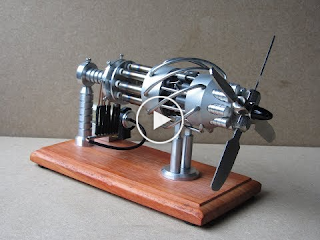16 Cylinder Stirling Cycle Aero Engine
A stirling engine is a heat engine operating by cyclic compression and expansion of air or other gas, the working fluid ,at different temperature levels such that there is a net conversion of heat energy to mechanical work.The engine was first invented in 1816 by “ROBERT STIRLING” so its name came to be stirling engine.
Why Stirling Engine? Best teaching and learning for any engineering students device especially in the field of thermodynamics. Unique technology. An innovation with hundreds of application. An innovation with a mission to save the earth. Fuel independency.
Why Stirling Engine? Best teaching and learning for any engineering students device especially in the field of thermodynamics. Unique technology. An innovation with hundreds of application. An innovation with a mission to save the earth. Fuel independency.
- Main Components
- • Power piston – small tightly sealed piston that moves up when the gas inside the engine expands • Displacer – larger piston and it is very loose in its cylinder so air can move easily between the heated cooled sections of the engine as the displacer moves up and down • These piston move by the action of compression and expansion. • Difference in pressure causes the piston to move and produce power.
- Working Principle
- I. One side of the engine is continuously heated while the other side is continuously cooled.
- II. First, the air moves to the hot side, where it is heated and it expands pushing up on a piston.
- III. Then the air moves through the regenerator to the cold side, where it cools off and contracts pulling down on the piston.
- IV. Temperature change inside the engine produces the pressure change needed to push on the piston and make the engine run.
- Configurations There are three major types of Stirling engines, that are distinguished by the way they move the air between the hot and cold areas: • The alpha configuration • The beta configuration • The gamma configuration
- The alpha configuration • There are two cylinders. • The expansion cylinder (red) is maintained at a high temperature • while the compression cylinder (blue) is cooled. • The passage between the two cylinders contains the regenerator.
- Beta type Stirling engine • There is only one cylinder, hot at one end and cold at the other. • A loose fitting displacer shunts the air between the hot and cold ends of the cylinder. • A power piston at the end of the cylinder drives the flywheel.
- The gamma configuration • The Stirling gamma configuration is simply a Stirling beta engine in which the power piston is not mounted coaxially with the displacer piston but in a separate cylinder. • This avoids the complications of the of the displacer piston linkage passing through the power piston.
- Double - Acting Stirling (Swash Plate) Engine • This configuration has fewer mechanical parts than the other designs and is more suitable for higher power applications.
- Efficiency •Theoretically • Stirling engine efficiency = Carnot efficiency • Unfortunately working fluid or gas is not ideal this causes the efficiency to be lower than Carnot efficiency. • In fact, Stirling engine efficiency depends on • Temperature ratio (proportionally) • Pressure ratio (inversely proportional) • Specific heat ratio (inversely proportional)
- Advantages •Various heat sources (solar, geothermal, nuclear energy, waste heat, biological) •Environmental friendly •Heat is external and the burning of a fuel-air mixture can be more accurately controlled. •Operates at relatively low pressure and thus are much safer than typical steam turbines ?•Less manpower needed to operate any type of commercial Stirling engine.
- Disadvantages • The price : its cost is probably the most important problem, it is not yet competitive with other means well established. • The ignorance of this type of engine by the general public. Only a few fans know it exists. It is therefore necessary to promote it. • The variety of models prevents standardization and, consequently, lower prices. • Sealing problems • Heat transfers with a gas are delicate and often require bulky apparatuses. • The lack of flexibility.
- Applications •Water pump stations •Combined heat and power plant •Solar power generation •Stirling cyrocoolers •Heat pump •Marine engines •Nuclear power •Aircraft engines •Micro CHP Visit www.seminarlinks.blogspot.com to download
- Applications WATER PUMP STATION • A Stirling engine used for pumping water can be configured so that the water cools the compression space. This is most effective when pumping cold water.
- Applications •STIRLING CYROCOOLERS • Any Stirling engine will also work in reverse as a heat pump. When a motion is applied to the shaft, a temperature difference appears between the reservoirs. • NUCLEAR POWER • Replacing the steam turbines of the nuclear power plant with Stirling engine might simplify the plant, yield greater efficiency, and reduce the radioactivity by products...






Post a Comment